

10 Ways to Spot a Fake News Article - EasyBib Blog. For many of us, 2016 is going down as a year to forget.

Election upsets, Zika, the Syrian crisis, and unfortunately tons of fake news about all of the above and everything in between. Denzel Washington was recently quoted as saying, “If you don’t read the newspaper, you’re uninformed. ABC Education: MEDIA LITERACY. All About Explorers. All About Explorers was developed by a group of teachers as a means of teaching students about the Internet.
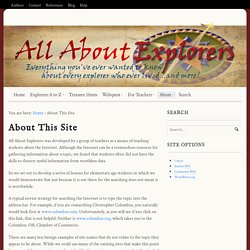
Although the Internet can be a tremendous resource for gathering information about a topic, we found that students often did not have the skills to discern useful information from worthless data. So we set out to develop a series of lessons for elementary age students in which we would demonstrate that just because it is out there for the searching does not mean it is worthwhile. A typical novice strategy for searching the Internet is to type the topic into the address bar. A Closer Look: Beware of Photos Bearing False Captions. When working with historical photo collections, it always pays to ask yourself: Does the title match the content?
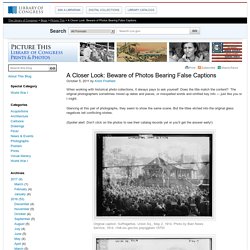
The original photographers sometimes mixed up dates and places, or misspelled words and omitted key info — just like you or I might. Glancing at this pair of photographs, they seem to show the same scene. But the titles etched into the original glass negatives tell conflicting stories. (Spoiler alert: Don’t click on the photos to see their catalog records yet or you’ll get the answer early!) Original caption: Suffragettes, Union Sq., May 2, 1914. Original caption: Union Sq., 5/1/14. A Conspiracy Video Teaches Kids A Lesson About Fake News. After Comet Ping Pong and Pizzagate, teachers tackle fake news. History teacher Chris Dier was in the middle of a lesson last week at Chalmette High School in Chalmette, La., when a student made a befuddling inquiry: “He raised his hand and asked if I knew about Hillary Clinton using pizza places to traffic people.”
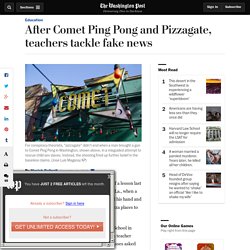
About a thousand miles away at Wilson High School in Northwest Washington, distressed students in teacher Eden McCauslin’s history and government classes asked why a North Carolina man armed with an assault rifle had appeared at their local pizza shop, Comet Ping Pong, telling police that he wanted to free child sex slaves he believed to be harbored there, a false narrative conspiracy theorists have pushed on the Internet. [Pizzagate: From rumor, to hashtag, to gunfire in D.C.] Hoaxes, fake news and conspiracy theories have abounded on the Web, spreading with increasing speed and intensity during the recent presidential election cycle. Bad News. Battling Fake News in the Classroom. In this post-election period, there has been a lot of discussion about fake news, particularly about how it is spread and shared online, and whether it influenced the recent presidential election.
On November 22, Stanford University released an influential study showing that middle and high school students—and even some in college—have trouble distinguishing which online resources are credible. The inescapable fact is that young people need to be prepared for the Wild West of information that they live in and will grow up in. It is also imperative that we, as educators, prepare young people for the important job of responsible and informed citizenship. Boilerplate’s Origins. Paul came up with the concept for Boilerplate years before the robot appeared in our books.

Initially, he thought about using it in a graphic novel. That evolved into the idea of telling the robot’s story in a more “realistic” way, illustrated by doctored photographs and set against world history as a backdrop. In the year 2000, which for so long sounded like the future but is now in the past, Paul decided to post some robot stories on our website. Not, contrary to some accounts, as a book pitch—he did it just for fun. He built a model robot, photographed it, digitally inserted it into vintage photos, and posted short stories on our old website. Those early Boilerplate stories were published as interstitial material in our graphic novel Heartbreakers Meet Boilerplate. Eventually, we did put together a book proposal and landed with Abrams Books.
The Book Chook: Help Kids Detect Fake News. By Susan Stephenson, www.thebookchook.com.

Checkology. Civic Online Reasoning Classroom Poster. Crash Course: Navigating Digital Information with John Green. Dihydrogen Monoxide Research Division - dihydrogen monoxide info. Drop Bear. The Drop Bear, Thylarctos plummetus, is a large, arboreal, predatory marsupial related to the Koala.
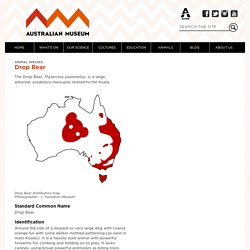
Drop Bear distribution map Photographer: © Australian Museum Standard Common Name Drop Bear. Don’t Believe Everything You Hear or Read. Mars Peopled by One Vast Thinking Vegetable!
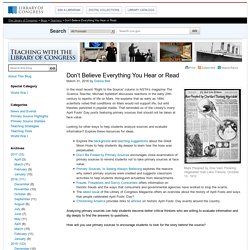
Salt Lake Tribune, October 13, 1912 In the most recent “Right to the Source” column in NSTA’s magazine The Science Teacher, Michael Apfeldorf discusses reactions in the early 20th century to reports of life on Mars. He explains that as early as 1894, scientists noted that conditions on Mars would not support life, but wild theories persisted in popular media. That reminded us of the Library’s many April Fools’ Day posts featuring primary sources that should not be taken at face value. Looking for other ways to help students analyze sources and evaluate information? Fakebook. Fake news. It's complicated. - First Draft News. This article is available also in Deutsch, Español, Français and العربية By now we’ve all agreed the term “fake news” is unhelpful, but without an alternative, we’re left awkwardly using air quotes whenever we utter the phrase.
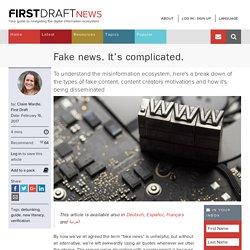
The reason we’re struggling with a replacement is because this is about more than news, it’s about the entire information ecosystem. And the term fake doesn’t begin to describe the complexity of the different types of misinformation (the inadvertent sharing of false information) and disinformation (the deliberate creation and sharing of information known to be false). To understand the current information ecosystem, we need to break down three elements: Fake News Or Real? How To Self-Check The News And Get The Facts : All Tech Considered. Guido Rosa/Getty Images/Ikon Images Fake news stories can have real-life consequences.
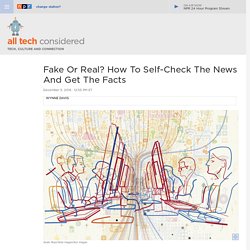
On Sunday, police said a man with a rifle who claimed to be "self-investigating" a baseless online conspiracy theory entered a Washington, D.C., pizzeria and fired the weapon inside the restaurant. So, yes, fake news is a big problem. These stories have gotten a lot of attention, with headlines claiming Pope Francis endorsed Donald Trump in November's election and sites like American News sharing misleading stories or taking quotes out of context. And when sites like DC Gazette share stories about people who allegedly investigated the Clinton family being found dead, the stories go viral and some people believe them.
Stopping the proliferation of fake news isn't just the responsibility of the platforms used to spread it. The idea is that people should have a fundamental sense of media literacy. Fake news lesson plan. Finding and Evaluating Web Sites. How Savvy are Your Students?: 7 Fake Websites to Really Test Their Evaluation Skills. Lesson Idea: Media Literacy and Fake News. Overview: In a world filled with rapid pace communication through a variety of platforms, we have an abundance of information available at our fingertips. Discerning fact from fiction can be complex. Knowing the source can be challenging, and the messages being delivered can be received in different ways, effecting certain populations of people as well as our country. Log In - New York Times. How Photos Fuel the Spread of Fake News.
How to Spot Fake News (and Teach Kids to Be Media-Savvy) How to Spot Fake News. Fake news is nothing new. But bogus stories can reach more people more quickly via social media than what good old-fashioned viral emails could accomplish in years past. Concern about the phenomenon led Facebook and Google to announce that they’ll crack down on fake news sites, restricting their ability to garner ad revenue.
Perhaps that could dissipate the amount of malarkey online, though news consumers themselves are the best defense against the spread of misinformation. Identifying Fake News: An Infographic and Educator Resources - EasyBib Blog. iReporter. Metafact. Protect Yourself from Fake News - Fact v. Fiction - Fake News - Academic Guid... Here are some steps you can take to become a critical news consumer: Determine what type of article you are reading Is it an editorial or opinion piece?
These articles reflect the author's personal beliefs and point of view. Untrustworthy sources can blur the line between reporting the facts and expressing opinions. Be sure to read carefully. Look into opposing views. Quartz - Schools around the world are now teaching kids to... How to identify fake news. Save The Pacific Northwest Tree Octopus. The Smell Test: Educators can counter fake news with information literacy. Here’s how. Swiss university launches country's first ever degree in yodelling.
3rd – 5th Grade Search Lesson. Teaching digital literacy in a new era of skepticism. Teaching Students about Fake News in the Real World — Literacy Ideas. Thou shalt not commit logical fallacies. Today's news: Real or fake? [Infographic] Truth and the Modern Classroom.
Turn Students into Fact-Finding Web Detectives. Fact-Checking Tips and Tools for Teachers and Students Show students where to look for credible information on the web. Explain that professional fact-checkers may already have done this important work for us.
Who Stands Between Fake News and Students? Educators. What these teens learned about the Internet may shock you! When the AP United States history students at Aragon High School in San Mateo California, scanned the professionally designed pages of www.minimumwage.com, most concluded that it was a solid, unbiased source of facts and analysis.